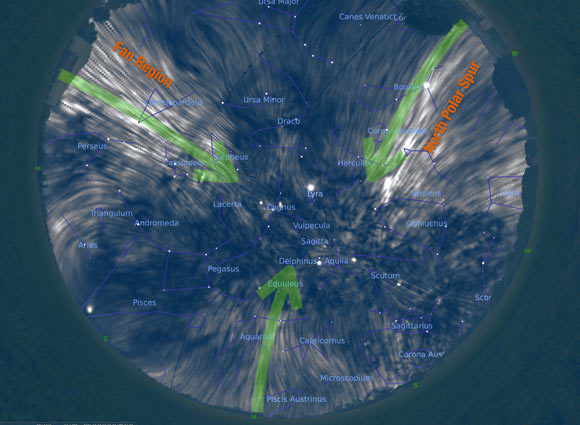The North Polar Spur and the Fan Region are two bright, large-scale radio structures that are seen on opposite sides of the sky. According to new research, they are actually connected and are made of long, magnetized, parallel filaments; this connection forms what looks like a tunnel around our Solar System.

Illustrated map of Milky Way Galaxy shown with the position and size of proposed filaments; inset shows a more detailed view of the Local environments, and the position of Local Bubble and various nearby dust clouds. Image credit: NASA / JPL-Caltech / R. Hurt, SSC & Caltech / J. West.
“If we were to look up in the sky, we would see this tunnel-like structure in just about every direction we looked — that is, if we had eyes that could see radio light,” said Dr. Jennifer West, an astronomer at the Dunlap Institute for Astronomy and Astrophysics at the University of Toronto.
“Called the North Polar Spur and the Fan Region, we’ve known about these two structures since the 60s.”
Dr. West and colleagues believe they are the first astronomers to connect these structures as a unit.
Made up of charged particles and a magnetic field, the North Polar Spur and the Fan Region are shaped like long ropes.
They are located about 350 light-years away from us and are about 1,000 light-years long.
“In 1965, astronomers speculated that these polarized radio signals could arise from our view of the Local Arm of the Galaxy, from inside it,” Dr. West said.
“That paper inspired me to develop this idea and tie my model to the vastly better data that our telescopes give us today.”

The sky as it would appear in radio polarized waves; the Van-Gogh-like lines show magnetic field orientation. Image credit: Stellarium / J. West.
The researchers built a computer model that calculated what the radio sky would look like from Earth.
The model allowed them to build the structure around the Solar System, and showed them what the sky would look like through the modern telescopes.
“This is extremely clever work,” said Professor Bryan Gaensler, also from the Dunlap Institute for Astronomy and Astrophysics at the University of Toronto.
The team’s ‘tunnel’ model not only brings new insight to the science community, but also a ground-breaking concept for the rest of us, on the ground.
“I think it’s just awesome to imagine that these structures are everywhere, whenever we look up into the night sky,” Dr. West said.
The results will be published in the Astrophysical Journal.
_____
J.L. West et al. 2021. A Unified Model for the Fan Region and the North Polar Spur: A bundle of filaments in the Local Galaxy. ApJ, in press; arXiv: 2109.14720







